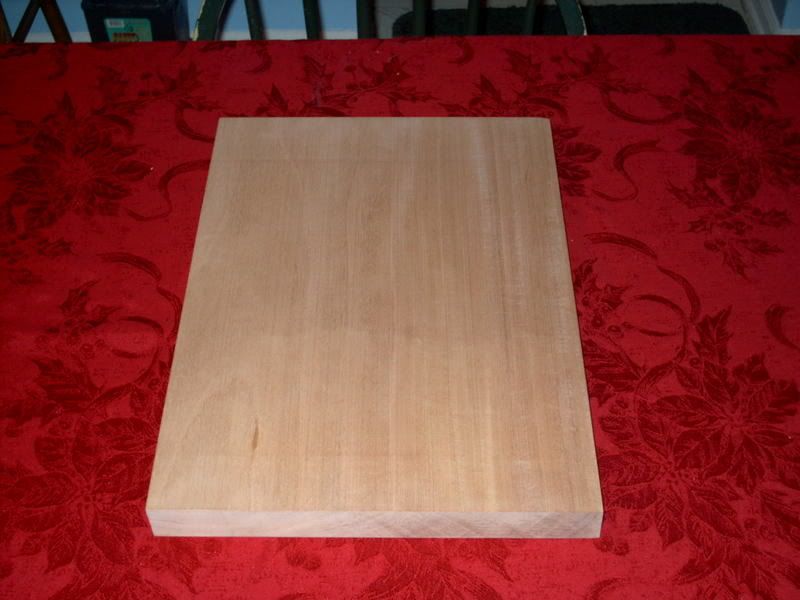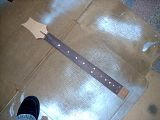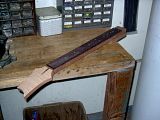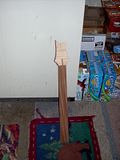-
Posts
410 -
Joined
-
Last visited
Content Type
Profiles
News and Information
Tutorials
Product Reviews
Supplier Listings
Articles
Guitar Of The Month
Links and Resources
Forums
Gallery
Downloads
Posts posted by Inisheer
-
-
Thanks for the link, RjY, I plan on using that when the time comes. And I'll take everyone's advice and try a recurve to make the carve look deeper.
Now for the progress: I've been working on the neck and fretted it. I was really worried about the whole fretting process. I used a cut off end from a radius sanding block in a drill press to install the frets. Then I had to level the frets, which didn't take as long as I thought it would. Then I bevelled the ends and sanded with fine grit sandpaper. It may not be the best, but it seems ok to me (everything lines up with a straightedge). Now I am starting to carve the back of the neck.
 Here is a pic of the fretted neck.
Here is a pic of the fretted neck.I also got my mahogany body blank today. It looks really nice, but is a lot lighter in color than the neck. Since I am doing a natural finish, the two pieces won't match as well as I would like.....perhaps when the finishing process comes around I will add a very light amount of brown stain to the body.

-
That is one of the most beautiful guitars I've seen for a while, you should be very proud. Now you need to show us how your second build is coming along.

-
Awesome!
 That is one nice looking guitar. You are right that the focus is on the bocote, but everything else looks cool too. I've never cared for teles much and hoped you wouldn't pick that design, but I must admit that I really like it.
That is one nice looking guitar. You are right that the focus is on the bocote, but everything else looks cool too. I've never cared for teles much and hoped you wouldn't pick that design, but I must admit that I really like it. 
-
Everyone seems to be saying that 3/4" is the optimal thickness. That would be .75- only a .06 difference from this top. This is approximately only 1/16" thinner, is that slight bit really going to make that much of a difference? And sorry, I guess I was wrong about the PRS specs.
 May I ask again which of those three choices I posted would be best, if any? I can use the 1" thick one (choice 2) and have a deeper carve, or should I stick with the .69" one? And thanks for all the input guys, I appreciate it.
May I ask again which of those three choices I posted would be best, if any? I can use the 1" thick one (choice 2) and have a deeper carve, or should I stick with the .69" one? And thanks for all the input guys, I appreciate it. 
-
I am not planning on doing a pale denim type thing. It will be a bit of a darker blue, pretty similar to that blue singlecut Maiden69 did a while ago. This should work then? And I know the carve won't be very deep. How thick was the top on that SC, Maiden? Also, Jeff Miller uses a 1/2" thick maple top on his guitar to carve and has faux binding. And doesn't PRS use 1/2" tops? This wood would allow the carve to be .19" deeper than those, so it should work fine, right? Option 2 is 1" thick, would this work better for my purpose? It is also more consistent in color.
-
Thanks everyone, choice 3 seems the most popular and that's what I liked best too. Since Mattia says the difference in coloring won't be too important, that settled my doubts. I have contacted Larry and told him I'd like the set. Next up is to order some mahogany.

-
I know good quilt is not cheap, but I would prefer not to spend $200 either. Here are some options I am considering:
Choice 1- 7/8" thick and $110....not sure how well the figure will show after staining though
Choice 2- 1" thick and $135....this seem good?
Choice 3- .69" thick and $95....looks good but I'm not sure about that lighter strip down the middle....
Any of these look good or should I keep searching?
-
I've been busy with school so I haven't been able to work on this much lately. I have the fingerboard glued, tapered and inlayed. Next is the part I'm scared of: fretting. I am also still searching for a quilted maple top....it's hard to find a nice set for a reasonable price. I have been talking to Larry at Gallery Hardwoods so hopefully he can help me out. Wish me luck!
-
I'm still searching for a nice maple top and have another related question. How bad is it if the piece is not entirely the same color. I don't mean mineral streaks and very different colors, but for example, if there is a maple set that has a lighter strip down the middle, will the stain get absorbed evenly and make the wood a consistent color, or will there still be an obvious strip down the middle?
-
I asked this question to an experienced builder on another forum, and he responded that he has also used epoxy for gluing fingerboards, but has recently switched to using polyurethane glue. He has built many excellent basses, so I believe that he knows what he is talking about. Any other comments? I still haven't decided what I'll use, but soon I'll make a choice and then stop bothering everybody.
 Thanks.
Thanks. -
It seems like people have had positive experiences with both types of glue. If I do decide to use epoxy, my next basic question is how do I use epoxy? I know it comes in two parts so how and in what should I mix them in and what should I use to spread it out with on the neck? Thanks for all the replies so far guys.

-
Hello, I know this seems like a basic question, but what kind of glue should I use to attach a fingerboard to the neck? I have searched this site, but can't find a definitive answer. I have seen some people recommend Titebond, while others claim that epoxy is the only good choice. Some people claim that backbow results from the moisture in Titebond, but others have used it without any trouble. These mixed opinions confuse me...what is really the best choice? I have never used epoxy before, but if that is best choice then I will learn to use it. Advice would be appreciated.

-
Thanks Jason!
 For my birthday my family wanted to get me some tools, but they don't really know what kind of tools I would use. They ended up getting me a scroll saw (worth about $180). Since they weren't sure if I'd use it, they said I could take it back and exchange it for something else if I prefer. It looks pretty nice, I'm just not sure I'd get too much use out of it. I've seen people use scroll saws to make matching wood covers for the back of the guitar, but they don't seem to be used for much else. Rick, what all do you use your router table for? I may consider getting one, if I can think of good uses for it. Also, one of those Safe-T-Planer things for the drill press might be a nice addition....any thoughts? Thanks for the comments.
For my birthday my family wanted to get me some tools, but they don't really know what kind of tools I would use. They ended up getting me a scroll saw (worth about $180). Since they weren't sure if I'd use it, they said I could take it back and exchange it for something else if I prefer. It looks pretty nice, I'm just not sure I'd get too much use out of it. I've seen people use scroll saws to make matching wood covers for the back of the guitar, but they don't seem to be used for much else. Rick, what all do you use your router table for? I may consider getting one, if I can think of good uses for it. Also, one of those Safe-T-Planer things for the drill press might be a nice addition....any thoughts? Thanks for the comments. -
Hello, I am trying to decide what tools to add to my workshop next and would like some advice. So far I have a router, bandsaw, miter saw, drill press, angle grinder, a small belt sander, and numerous hand tools. Would I get any use out of a scroll saw, or is that not much good for building guitars? Also, what about a router table? I know a lot of people here use router tables, but are they necessary for anything? I have seen them used for routing the channel for the truss rod, but I can do that fine without the router table. Any recommendations for other types of tools that I would need?
-
Am I the only person who thinks this sounds like... a PRS, rather than a hybrid? In a nutshell, what's the differentiating factor? I can't seem to focus on the description and replies for some reason.
I agree, this does seem pretty standard, not really some new type of hybrid guitar, which is why I said in the first reply that his plans don't seem that out of the ordinary. As for the thickness, I agree about the weight issue. If you make it too thick, chambering it would be a great idea. If you want a thick carved top guitar, I would recommend around 1.75-2" at the edges and up to 2.5" in the center...but it really is up to you (I am no expert on the topic, just sharing ideas).
-
1) Anything I am planning that is really unreasonable or a flat out bad idea?
There is nothing wrong with your idea. The cool thing about building guitars is that you can make them exactly how you want them. Your plans really don't seem that out of the ordinary either.
2) Any specific pearls of wisdom for doing this?Draw detailed plans of everything before you start any of the actual work.
3) How likely am I to get a decent looking, workable guitar with a really nice sound on my first time building a guitar?If you take your time you can definitely make a decent looking, workable guitar. If it's your first project, it may not be perfect, but it should be something you will be proud of.
4) Anything that might be particularly troublesome and worth outsourcing for a first-time project?Many people (including me) feel daunted by making necks and buy a premade neck for their first projects. But if you take your time, you can do it.

Overall, it sounds like you know what you want. A thick mahogany body with a carved maple top should help with that LP tone. I would also go with a 24.75" scale. If you have any woodworking experience, that is a plus. If not, do some research on the required tools and how to use them. Good luck!
-
There are often color variations in quilted and flamed maple, ie. some tops are very white in color, while some are more of a yellow, red, or brown. How important is it to get a whitish top if I am going to stain it blue? I realize that using a red dye on a reddish colored piece won't matter quite as much, but what would happen if a darker piece was stained blue? I imagine that the other colors would prevent the blue from being as well defined, and might make it look more green or purple or something, right? If there are any problems with staining these, then I will be sure to find the whitest wood possible. Any comments would be appreciated.
-
Cool! Nice job on the refinish, it looks great. The pickguard goes well with it too.

-
I also like the top two designs best.....the middle left one kind of looks like the United States. If you are going to have the focus on the body with the metal and aerial art, I would recommend having the fingerboard fairly simple. Maybe have a polished aluminum headstock to match, with that 'mouth' design at the end of the headstock? Aged, rusted looking hardware might fit in with that theme too. Good luck with the project!
-
As already stated, opinions are personal and nobody will be able to affect another person's. There are some people on this board, like Greg, that hate maple tops and double humbuckers, but that happens to be something I really like. Neither of our opinions will change, and hopefully there are no hard feelings between anyone on this board due to that fact. Each person is entitled to vote for whom they choose and why they chose it. Both looks and skills used are how I determine who to vote for. I have voted for guitars before that looked very nice, but there were some flaws in the building. I have also not voted for other builds which were far superior in quality, but I personally thought they were not that visually appealing. The point is that there are no particularities for how I vote. A project does not have to have fancy woods or perfect craftsmanship. I vote for the guitar that would catch my attention at a store and make me want to play it.
Like others have said though, this vote does not lift up any of the builders while criticizing the rest, it is more of a place to share what we like about each of the projects. Personally, I would be proud to own any one of the entries this month. Congratulations to all of you, regardless of how many votes you get. Instead of looking at each other now, can we get back to looking at the guitars?

-
-
Mahogany's cheap enough to us a more 'perfect' blank, although it's also stable enough that I doubt it'll actually be much of a problem (using what you have, that is). Shouldn't cost much more than 10 to 15 bucks, after all, and its a guitar that should last a lifetime in the end.
As for the quilt, wait for the top. It's worth having matching wood (ie, from the same piece) if you're going to match headstock and body anyway.
So it is stable enough? I think I will use this for now then. I will try to do some work on the neck...I can add quilted veneer later in the process right, that doesn't necessarily have to be the first step? Thanks for all the help and comments guys.

-
Hmmm, I'm running into a lot of problems and I've barely started.
 So would it be best to use this neck blank or start over?
So would it be best to use this neck blank or start over? -
You don't need to buy a veneer! All you have to do is cut it from the excess of the top
If I happen to get a maple top soon then I'll try that, but if not I think it would just be easier to buy some veneer.






Blue Prs Project
in In Progress and Finished Work
Posted
Yes, I did that too. I had planned on being cheap and using a regular file to carefully recrown each side of the frets, but I ended up getting a specialty crowning file from stewmac, which was probably a better choice.